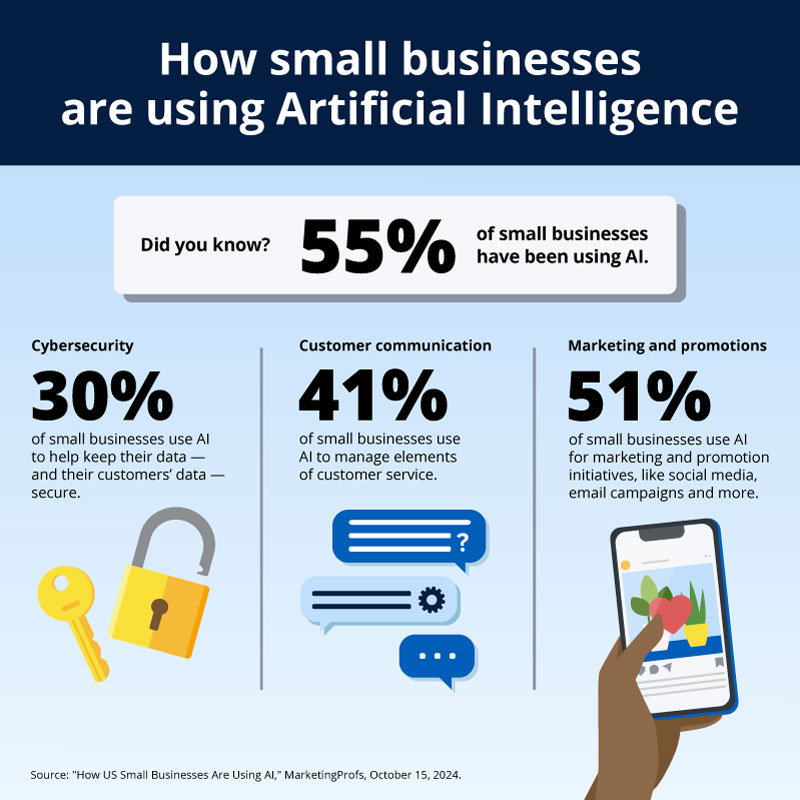How small business owners can safely use AI to help boost their efficiency
Learn how AI can safely and efficiently enhance your business success. Presented by Chase for Business.

You know your business inside and out. You know which suppliers always deliver early, which customers prefer texts over emails and exactly how your team members handle their day-to-day routines. That deep understanding of your business is about to become your strongest asset in navigating the world of artificial intelligence (AI).
Every business owner today faces two quandaries about AI: how to use it safely, and how to use it effectively. These aren’t separate challenges — they’re two sides of the same coin.
As AI tools become more sophisticated, so do AI-powered threats. For every helpful tool that can schedule your meetings or analyze your sales data, there’s a scammer using AI to create convincing deepfakes or targeted phishing attacks.
The good news? You can protect your business while still taking advantage of what AI offers. This guide shows you how to spot possible AI-related threats, put simple safeguards in place and then use AI effectively to help your business grow.
Understanding AI security in business
When we talk about how to safely use AI for small business, it’s not just about avoiding scams. It’s about understanding all the ways AI could impact your business — both good and bad — and making smart decisions about how to use it.
Think of AI security like hiring a new employee. You wouldn’t give a new hire complete access to everything on day one. You’d train them, watch their work and gradually give them more responsibility as they prove themselves. AI tools require the same careful approach.
Business data security and privacy
Every time you use an AI tool, you share business information with it — including customer data and financial records. Here’s how to help protect that information:
- Check your data storage. When you use AI tools, your business data is stored on their computers, not yours. Consider using AI companies or tools that retain the collected data in the U.S.
- Review privacy settings. Established AI tools let you choose which information they’ll save and how long they’ll keep it. Many offer the option to delete your chats afterward or to set time limits on data retention.
- Read the terms of service carefully. Before using any AI tool, make sure you understand its rules. How long will it keep your information? Will your information be shared? Who owns the work the AI creates with your data? If you can’t find clear answers, think twice about using the tool.
- Guard your customers’ privacy. Keep sensitive information like credit card numbers and contact details away from AI tools. When you’re testing something new, use made-up information instead of real customer data. Once your customer data is shared with an AI tool, you can’t take it back.
Protecting your business against AI threats
AI-powered threats are getting more sophisticated every day, but security doesn’t have to be complicated. In fact, the simpler your plan, the more likely your team will follow it. The key areas to watch out for are pretty straightforward:
- Deepfake videos and voice calls – Scammers are using AI to create fake videos and voice calls that look and sound just like people you know. These scams can trick you into sending money or sharing sensitive information before you realize you’re not talking to who you think you are.
Stopping deepfake fraud:- Set up a code word or phrase with your team that means “I need to verify this is really you.”
- Establish a process to call back the person who requested a money transfer — using their regular phone number.
- Have clear steps for verifying any unusual video or voice requests.
- Keep video calls on your approved business platforms only.
- Smart phishing – AI can now mimic your company’s writing style almost perfectly, making scam emails difficult to spot. One wrong click could give scammers access to your accounts or trick you into sending money to the wrong place.
Preventing AI phishing attacks:- Create a checklist for spotting AI-generated scams.
- Talk about new AI threats in your regular team meetings.
- Practice what to do if someone spots something suspicious.
- Set up a clear system for reporting suspicious activities.
- Use good spam filters that can catch AI-generated phishing emails.
- Fake services – Not every company offering AI for small business is legitimate. Some are scammers trying to get access to your business data. One wrong choice could expose your sensitive information or give hackers a way into your business.
Protecting against fake services:- Keep a list of who on your team is allowed to sign up for new AI tools.
- Do your homework on AI vendors before sharing any data.
- Always check for security certificates and HTTPS connections.
- Double-check where messages are really coming from.
- Use authenticator apps instead of text messages for verification.
Above all, remember that while AI can pretend to be human, you know how Carlos from marketing writes his emails. You know Sariah from accounting never asks for a rush payment. You know how your customers normally order something from you. And that deep understanding of your business and your customers is something no algorithm can fake.
What AI can (and can’t) do for your business
AI security might seem overwhelming, but it doesn’t have to be scary. Once you have your basic protections in place, you can safely explore what AI can do for your business. The main thing to keep in mind is that what we call AI is actually a collection of different tools, each with its own strengths and limitations.
- Machine learning — That’s when computers get better at tasks by studying examples, like how your phone learns to recognize your face or how Netflix figures out what shows you might like.
- Large language models (LLMs) — These tools are incredibly good at working with text because they’ve processed millions of documents, but they’re basically very sophisticated pattern-matching tools. They can help write emails or summarize reports, but they don’t understand what they’re writing.
- Generative AI — These tools are great for creating graphics that you can use for simple things like social media posts. But they work best when guided by human creativity, especially when you want your business to look unique rather than like a clone of your competition.
- Computer vision — These tools help machines “see” and analyze images. It powers those apps that can identify plants from photos or help doctors spot issues in X-rays.
But they’re all just tools. Really powerful tools, sure, but still tools. And as with any tool, using AI safely works best when humans use it for the right job. A nail gun is great for framing a house, but you wouldn’t use it to hang a family photo. AI is like that — fantastic for crunching numbers or handling boring tasks, but it can’t replace your understanding of what makes your business tick.
Enhancing your efficiency with AI
Now that you know how to protect your business and the types of tools available, let’s look at what AI can do for you to make your business more efficient. Think about the things you don’t like doing at work. The tedious reports. The midnight spreadsheets. The tricky scheduling. AI can help handle the work that doesn’t need your uniquely human touch so you can focus on the work that does.
Here’s what AI can help safely take off your plate:
- Administrative tasks: Let AI handle the grunt work, such as scheduling your meetings and sending out invoices.
- Data analysis: Instead of spending hours poring over spreadsheets, let AI spot trends in your sales and inventory.
- Routine communications: Those everyday emails and social media posts? AI can help write them and even figure out when they’ll reach the most people.
- Basic customer service: Free yourself up for the conversations that matter by letting an AI chatbot handle common questions like “What are your hours?”
- Process automation: Stop chasing unpaid invoices or remembering to send reminders. AI can keep these routine tasks moving while you focus on growing your business.
The key is to let AI handle these repetitive tasks so you can spend more time on what really matters — serving your customers better.
Making AI work for you
Once you’ve got your AI tools set up, it’s time to safely incorporate them in your daily workflow. Think of these tools like any new help you bring in: You need to show them what to do, check their work and make sure they’re actually making your life easier.
Keep tabs on things
- Start your day with a quick look at what’s been done, like checking those automated social media posts before they go live.
- Review any emails or responses your AI chatbot sent to customers overnight.
- Make sure your inventory alerts are catching things before you run out.
- Spot-check those automated invoices and appointment reminders.
Set clear boundaries
- Decide which customer emails your AI can answer and which need your personal touch.
- Know when to let your chatbot handle questions and when to jump in yourself.
- Be careful with customer data — make sure your AI tools see only what they need to.
- Have a plan for when things need to shift from AI to human attention.
Watch and learn
- Pay attention to how customers react to AI-written emails or chatbot responses.
- Notice which routine tasks AI handles well (like scheduling) and which still need your focus.
- Keep an eye on whether these tools are actually saving you time and preventing headaches.
- Adjust settings when things aren’t quite hitting the mark.
You’re not trying to put your business on autopilot. You’re using these tools to handle the repetitive stuff so you can focus on the hands-on parts of your business that make it unique.
Use AI safely to help grow your business
When it comes to AI for small business, security and efficiency go hand in hand. The protections you’ve put in place — from securing customer data to spotting potential scams — aren’t just about avoiding problems. They’re about giving you the confidence to use AI safely and effectively. Because when you know how to protect your business from threats and scams, you can focus on putting AI to work where it can help the most.
Think about what that could mean for your business:
- You can confidently use AI tools, understanding how to manage data privacy concerns.
- You can let chatbots handle customer questions while maintaining control of your data.
- You can automate more daily tasks because you’ve got clear boundaries and oversight in place.
It’s pretty simple: When you know how to use AI safely, you can combine smart safeguards with strategic automation to unlock powerful business efficiencies.
Ready to explore how the right tools can help your business grow? Learn more with Chase for Business.





